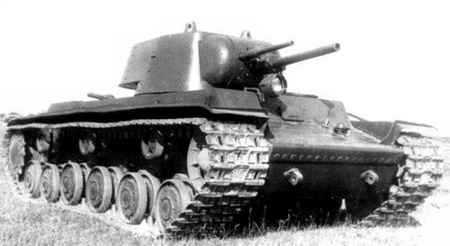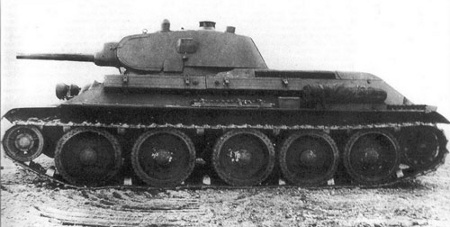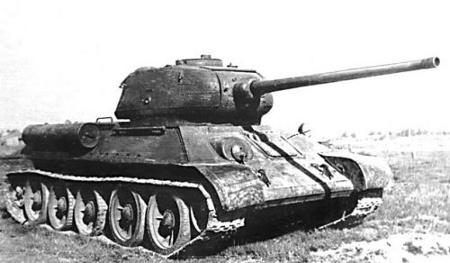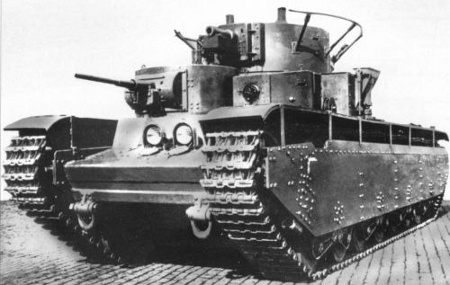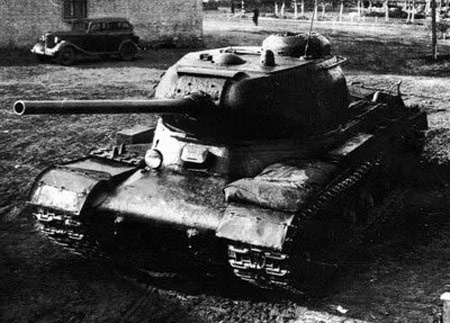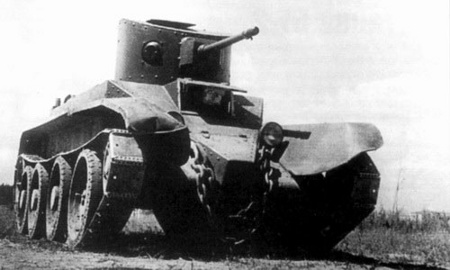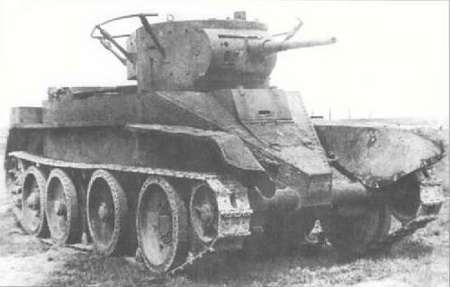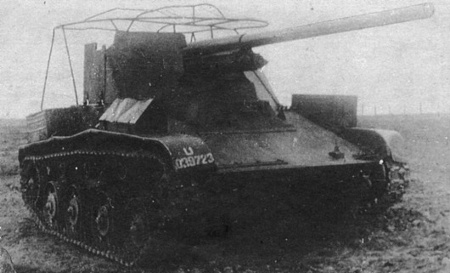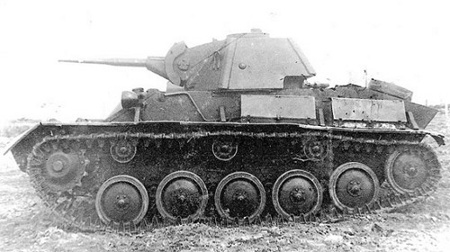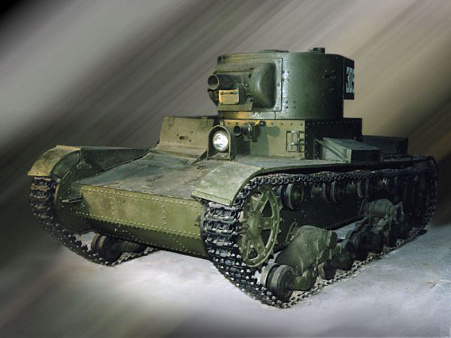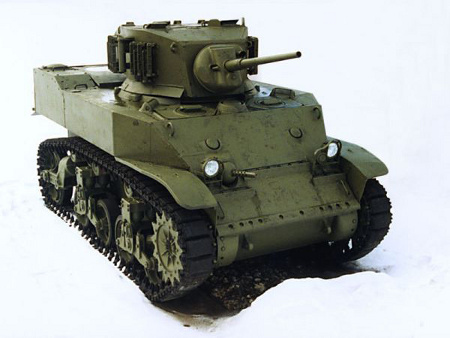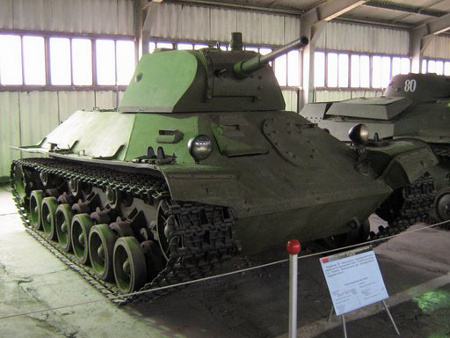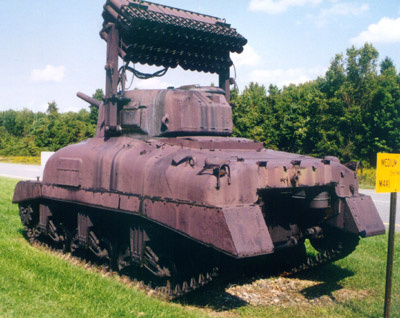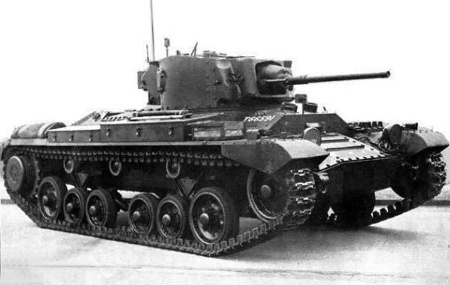Kliment Voroshilov tank
The Kliment Voroshilov (KV) tanks were a series of Soviet heavy tanks, named after the Soviet defense commissar and politician Kliment Voroshilov. At the time of the German invasion of the Soviet Union in World War II, about 500 KV tanks comprised a portion of Soviet tank forces. After disappointing results with the multi-turreted T-35 heavy tank, Soviet tank designers started drawing up replacements. The Spanish Civil War demonstrated the need for much heavier armor on tanks, and was the main influence on Soviet tank design just prior to World War II. It was decided to create one with only a single turret, but more armour. This new single-turret tank was the KV. The smaller hull size and single turret enabled the designer to add more armor while keeping the weight within manageable limits. When the Soviets entered the Winter War KV proved highly resistant to Finnish anti-tank weapons, making it more effective than the other designs. It was soon put into production, both as the original 76-mm-armed KV-1 Heavy Tank and the 152 mm howitzer-mounting assault gun, the KV-2 Heavy Artillery Tank. By 1942, when the Germans were fielding large numbers of long-barreled 50 mm and 75 mm guns, the KV's armor was no longer invincible, and other flaws came to the fore. While its 76.2 mm gun was adequate, it was the same gun as carried by smaller, faster, and cheaper T-34 medium tanks. Due to the new standardization, it shared the same engine, gun and transmission as the T-34, was built in large quantities, and received frequent upgrades. When production shifted to the Ural mountain 'Tankograd' complex, the KV-2 was dropped. The KV-2, while impressive on paper, had been designed as a slow-moving bunker-buster. The turret was so heavy it was difficult to traverse on non-level terrain, and it was expensive to produce. Only about 250 KV-2s were made, all in 1940-41, making it one of the rarer Soviet tanks. In response to criticisms, the lighter KV-1S was released, with thinner armour and a smaller, lower turret in order to reclaim some speed. The appearance of the German Panther tank in the summer of 1943 convinced the Red Army to make a serious upgrade of its tank force for the first time since 1941. Soviet tanks needed bigger guns to take on the growing numbers of Panthers and the few Tigers. A stopgap upgrade to the KV series was the short-lived KV-85. This was a KV-1S with a new turret designed for the KV-13, mounting the same 85 mm D-5T gun as the SU-85 and early versions of the T-34-85. Already-high demand for the gun slowed production of the KV-85 tremendously, and only 148 were built before the KV design was replaced. The KV-85 was produced in the fall and winter of 1943-44; they were sent to the front as of September 1943, and production of the KV-85 was stopped by the Spring of 1944 once the IS-2 entered full scale production.
Т-34
The T-34 was a Soviet medium tank produced from 1941 to 1958. It is widely regarded to have been the world's best tank when the Soviet Union entered World War II. It is credited as the war's most effective, efficient and influential design. First produced at the KhPZ factory in Kharkov (Kharkov, Ukraine), it was the mainstay of Soviet armoured forces throughout World War II, and widely exported afterwards. It was the most-produced tank of the war, and the second most-produced tank of all time. A 1996 publication showed that the T-34 was still in service with twenty-seven countries. The T-34 was developed from the BT series of fast tanks, and was intended to replace both the BT-5 and BT-7 tanks and the T-26 infantry tank in service. At its introduction, it was the tank with the best balanced attributes of firepower, mobility, and protection in existence, although initially its battlefield effectiveness suffered from the unsatisfactory ergonomic layout of its crew compartment, lack of radios and poor tactical employment. The two-man turret crew arrangement required the commander to also serve as the gunner; this proved to be inferior to the German arrangement of three men (commander, gunner and loader).The design and construction of the tank were continuously refined during the war to improve effectiveness and decrease costs. By the war's end in 1945, the versatile and cost-effective T-34 had replaced many light and heavy tanks in service, and accounted for the majority of Soviet tank production. By the end of 1945, over 57,000 T-34s had been built: 34,780 original T-34 tanks in 1940–44, and another 22,559 T-34-85s in 1944–45. In 1946, 2,701 T-34s were built, and large-scale production ceased. Production was restarted under license in 1951 in Poland and Czechoslovakia, where 1,380 and 3,185 T-34-85s were made, respectively, by 1956. Later, T-54/55 and T-72 tanks were also built outside the Soviet Union.
Т-34-85
In 1943 in connection with the appearance of new German tanks T-V “Panther”, T-VI “Tiger” the work on modernization of T-34 began. Thanks to reserves of this tank it could be possible to raise technical characteristics of it not changing its basic components. In 1944 there was constructed a modernized T-34-85 with 86mm gun placed in a three-men cast steel turret, with 90 mm front armour thickness, commander’s cupola, and 5-speed transmission gear box. There appeared one more member of crew – tank loader. The tank was being designed in KB of the factory N 183 (Nizhniy Tagil) under the guidance of A. A. Morozov. Passed into service in Red Army in January, 1944, was manufactured at factories N 183, 112 “Krasnoe Sormovo” (Gorky), N 174 (Omsk). Since 1944 till 1945 there were manufactured 21 000 units. Soviet 85-mm tank gun with lower weight was equal to 88-mm gun of German T-VI “Tiger”. Long-barrel gun, the best optics, high reliability let T-34-85 to fight against German tanks of any type, including heavy tanks. In spring, 1944 T-34-85s were used in a battle for the first time. Mass usage of T-34-85s began in 1945 in following operations: Vistula-Order, Pomeranskaya, Berlin operations, in the battle of Balaton lake (Hungary). Great number of T-34-85 was sent to Poland, Czechoslovakia, Yugoslavia. T-34-85s were used in the Soviet Union until 1970-s. battle tanks of this type were in operational service of Countries of the Warsaw Pact, and 28 countries of Europe, Asia, Africa, and South America.
T-35
The T-35 was a Soviet multi-turreted heavy tank of the interwar period and early Second World War that saw limited production and service with the Red Army. It was the only five-turreted heavy tank in the world to reach production but proved to be slow and mechanically unreliable. Most of the T-35 tanks still operational at the time of Operation Barbarossa were lost due to mechanical failure rather than enemy action. Outwardly it was large but internally the spaces were cramped with the fighting compartments separated from each other. Some of the turrets obscured the entrance hatches. The T-35 was developed by the OKMO design bureau of the Bolshevik Factory. By July 1932, a prototype of a 35 ton tank with a 76.2 mm tank gun was completed. The first prototype was further enhanced with four smaller turrets, two with 37 mm guns and two with machineguns. This first prototype had severe defects in its transmission. Therefore work on it was stopped and a new simpler prototype was built. This new prototype received a new engine, new gearbox and improved transmission. The decision was also made to standardize the turrets used on the T-35 with those used on the T-28, a triple-turreted medium tank. The small machinegun turrets were identical on the two tanks. The large main turret housing the 76.2 mm gun was nearly identical. On August 11, 1933, the T-35 was accepted for production. Engineering was shifted to the Kharkov Locomotive Factory, and two batches of ten vehicles were completed. The experiences gained with the two prototypes were used for the main production T-35 Model 1935, which was again improved from the second prototype, with a longer chassis, improved hull and 45 mm guns in place of the 37mms. It started production in 1935, and about 35 were built by 1938. Production models had turrets similar to the ones on the BT-5, but without the rear overhang. Some models had flamethrowers instead of one of the 45 mm guns. The final batch was a run of six T-35 model 1938s, which had new turrets with sloped armor all around, as well as modified side skirts and new idler wheels. Due to its high cost, the production run of the T-35 ended at just sixty-one tanks. The T-35 served with the 5th Separate Heavy Tank Brigade in Moscow, primarily for parade duties, from 1935 until 1940. In June 1940, the question was raised whether to withdraw the T-35s from frontline service, with the option to either convert them to heavy self propelled artillery, or to assign them to the various military academies. The choice was made to use them up in combat instead and the surviving vehicles were collected together into the 67th and 68th Tank Regiments of the 34th Tank Division, which served with the 8th Mechanized Corps in the Kiev Special Military District. During Operation Barbarossa, ninety percent of the T-35s lost by the 67th and 68th Tank Regiments were lost not to enemy action but through either mechanical failure or because they were abandoned and destroyed by their crews.
IS tanks
The Joseph Stalin tank (or IS tank, named after the Soviet leader Joseph Stalin), was a heavy tank developed by the Soviet Union during World War II. The tanks in the series are also sometimes called JS or ИС tanks. The heavy tank was designed with thick armour to counter the German 88 mm guns, and sported a main gun that was capable of defeating the new German “Tiger” and “Panther” tanks. It was mainly a breakthrough tank, firing a heavy high-explosive shell that was useful against entrenchments and bunkers. The IS-2 was put into service in April 1944, and was used as a spearhead in the Battle for Berlin by the Red Army in the final stage of the war. The main production model was the IS-2, with the powerful A-19. It was slightly lighter and faster than the heaviest KV model 1942 tank. The tank could carry thicker armour than the KV series, while remaining lighter, due to the better layout of the armour envelope. The IS series concentrated the heaviest armour up front. The A-19 122mm gun had very good armour penetration, delivering 3.5 times the kinetic energy of the older 76.2mm gun, and when it didn't penetrate, could often knock a turret right off a tank with the combination of the impact and explosive filler. Its very large high explosive shells were very effective against bunkers, infantry and antitank guns. The main disadvantage of the gun was its huge, two-part ammunition, which were difficult to manhandle, slow to reload (the rate of fire was only about two rounds per minute), and only allowed 28 rounds to be carried. Improved IS-2s (the model 1944), had a faster-loading version of the gun, the D25-T with a double-baffle muzzle brake and better fire-control. It also featured a simpler hull front without a "step" in it (using a flat, sloping glacis armour plate). Other minor upgrades included the addition of a travel lock on the hull rear, wider mantlet, and, on very late models, an antiaircraft machine gun. The IS-2 tank first saw combat in the spring of 1944. IS-2s were assigned to separate heavy tank regiments, normally of 21 tanks each. These regiments were used to reinforce the most important attack sectors during major offensive operations. Tactically, they were employed as breakthrough tanks. Their role was to support infantry in the assault. They were also capable of taking on any German AFV if the need arose. The IS-2 weighted about the same as a German “Panther”, and was lighter than the German heavy tanks, the “Tiger” series. One of the IS-2's most notable engagements took place during the fighting in August 1944 to establish a bridgehead across the river Vistula around the town of Sandomierz. This was the first time the IS-2 had come up against the fearsome “Tiger” II.
BT tank
The Fast Tank was a series of Soviet 'cruiser tanks' which were produced in large numbers between 1932 and 1941. They were lightly armoured, but reasonably well-armed for their time, and had much better mobility than other contemporary tank designs. The BT tanks were 'convertible tanks'. In about thirty minutes the crew could remove the tracks and engage a chain drive to the rearmost road wheel on each side, allowing the tank to travel at very high speeds on roads. BT tanks saw service in the Spanish Civil War, in the Far East, in the Winter War in Finland, the Polish campaign, and in the early part of World War II. The original Christie tanks were designated fast tanks by the Soviets, abbreviated BT. Based on the Christie prototypes and previously obtained plans, three unarmed BT-2 prototypes were completed in October 1931 and mass production began in 1932. Most BT-2s were equipped with 37 mm gun and one machine gun, but shortages of 37 mm guns led to some early examples being fitted with three machine guns. The BT-3 and later models were equipped with a 45 mm gun. The sloping front armor design of the Christie M1931 prototype was retained in later Soviet tank hull designs, later adopted for side armor as well. In 1937, a new design team was formed under Chief designer Mikhail I. Koshkin, to create the next generation of BT tanks. The team built a BT prototype called the A-20, but also built a more heavily armed and armoured derivative, the A-32, a "universal tank" to replace both the T-26 infantry tank and BT line of cruiser tanks. In the Second World War, BT-5s and BT-7s took part in the Soviet occupation of eastern Poland in 1939, and in large numbers in the battles of 1941. Most of these tanks were abandoned or destroyed in the disastrous 1941 campaign. A few continued in use in 1942, but they became quite rare after that time. The Red Army planned to replace the BT series with the T-34 and had just begun doing so when the German invasion (Operation Barbarossa) took place. In the Far East, a significant number of BT-7 tanks took part in Operation August Storm against Japan in Manchuria, during August 1945. This was the last combat action of BT-series vehicles. The BT series was numerous, forming the 'cavalry tank' arm of the pre-war Red Army, and had much better mobility than other contemporary tank designs.
BT-5
BT-5 was designed for increasing of combat effectiveness and handling characteristics of BT-2, in serial production since 1933 till 1934, manufactured more than 1800 units. Serial modification: BT-5 – second modification. New extended rear recess turret was installed. Armor: 45-mm gun and twin barreled machine gun DT with 72-115 shot ammunition. Soviet with 400 horsepower engine. Strengthened running gear, anti-fire equipment. Some tanks were equipped with radio stations. Weight 11.5 t. BT-5's were first used in action during the Spanish Civil War in 1936 when they fought on the Republican side against the Nationalists. BT's made up part of the large 500 stroke tank force under General Zhukov which took part in the influential battle of Nomonhan against the Japanese over the disputed area between Mongolia and Manchuria in August 1939. They participated in the carve up of Poland (in league with the Germans), and the invasion of Finland the same year. Used to help try and stem the German advance into the USSR during the German onslaught in 1941, many were dug in and used as fixed pill boxes when they ran out of fuel or broke down and couldn't be repaired due to the poor logistics of the Red Army at the time. Whilst they only had thin armour their gun was a very potent weapon when they were first built.
T-60 tank
The T-60 scout tank was a light tank produced by the Soviet Union from 1941 to 1942. In this time over 6,292 were built. The tank was designed to replace the obsolete T-38 amphibious scout tank. N.A. Astrov's design team at Moscow Factory No. 37 was assigned the task of designing amphibious and non-amphibious scout tanks in 1938. They produced the T-30A and T-30B prototypes. The former was to be manufactured as the T-40 amphibious tank starting in 1940. It also led to the T-40S ("dry-land" version), a heavier tank prototype which was considered too complex to manufacture. The T-30B prototype, sharing the T-40's chassis but simpler in construction and with heavier armour, was accepted as the T-60 scout tank, and began production in July 1941, just after the German invasion. Although at first intended to carry a 12.7 mm machine gun like the T-40, the armament was later upgraded to the 20 mm TNSh cannon, a tank version of the ShVAK, on the advisement of the Chairman of the Council of Ministers, V.A. Malyshev. This weapon could penetrate 15 mm of perpendicular armour at 500 m range which proved inadequate against the newer uparmored German tank designs thus attempts were made in 1942 to re-arm the T-60 with the 37mm ZIS-19 cannon but were abandoned due to the Soviet Union's shortage of 37mm ammunition. The T-60 was also used in the design of the experimental T-90 antiaircraft tank. This project switched to the T-70 light tank, and was finally cancelled without any production. One T-60 was converted into a glider in 1942 and was designed to be towed by a Petlyakov Pe-8 or Tupolev TB-3 bomber and was to be used to provide partisan forces with light armour. The tank was lightened for air use by removing armament, ammunition, headlights and leaving a very limited amount of fuel. Even with the modifications the TB-3 bomber had to ditch the glider due to the T-60's poor aerodynamics during its only flight to avoid crashing. The T-60 landed on a field near the airdrome and after dropping the glider wings and tail returned to its base. Due to lack of sufficiently powerful aircraft to tow it the project was canceled and never resumed. First massive usage of T-60s traced back to the battle for Moscow. Almost every tank brigade had these tanks. On November, 7th 1941 48 T-60 participated in Parade on the Red Square. T-60 were used on the Leningrad and South fronts in 1942. They were actively used in operation of Kharkov, in defence operation of Stalingrad. The last great operation in which T-60 participated was the lifting of blockade of Leningrad.
T-70
The T-70 light tank was used by the Red Army during World War II. The T-80 light tank was a more advanced version of the T-70 with a two-man turret—it was only produced in very small numbers when light tank production was abandoned. The T-70 was armed with a 45-mm L/46 gun Model 38 with forty-five rounds carried, and a coaxial 7.62-mm DT machine gun. The tank was operated by a driver and a commander who loaded and fired the gun. Armour thickness on the turret front was 60 mm, hull front and sides: 45 mm, rear and turret sides: 35 mm, roof and bottom: 10 mm. By 1942, light tanks were considered inadequate by the Red Army, unable to keep up with the T-34 medium tank and unable to penetrate the armour of most German tanks. But they could be produced by small factories which were unable to handle the large components of medium and heavy tanks. The T-70 was designed by N. Astrov's design team at Factory No. 38 in Kirov. The first batch of T-70s were built with a GAZ-202 automotive engine on each side of the hull, one driving each track. This arrangement was seen to be a serious problem, even before the first tanks were issued. It was quickly redesigned as the T-70M (although it continued to be referred to as just T-70), with the engines in-line on the right side of the tank and a normal transmission and differential. The conical turret was replaced by one more easily welded out of plate armour, and moved to the left side of the hull. Curiously, even after the T-70's production line was redesigned, SU-76 self-propelled guns started to be built with the same unsatisfactory unsynchronized two-engine layout, and all of them were later recalled for factory rebuilding as SU-76Ms. T-70s were put into production in March 1942 at factory No. 37, and along with T-60 production at GAZ and factory No. 38. They completely replaced T-60 production in September 1942, although that tank remained in use until the end of the war. Production ended in October 1943, with 8,226 vehicles completed. In April 1942, the conical turrets on early-production machines were replaced with new welded turrets. The T-70 remained in service until 1948.
OT-130 tank
OT-130 (ognemyotny tank – flame-throw tank) was designed in 1937 by constructors from K. E. Voroshilov factory (Leningrad). Since 1938 in operational service. It was created on the base of light tank T-26 of the year 1933. Characteristics of T-26 were preserved. In turret instead of gun there were installed a flame-thrower and a machine gun. Range of a missile was 35-50m. Flame-throw equipment was installed in fighting cabin (two containers for flame mixture: the total capacity is 400 liters.) OT-130s were in operational service of chemical troops of rifle and mechanized brigades and divisions. OT-130s were used in battles of the Khalkhin-Gol river. Later on they were gradually replaced by the modified variations OT-131, OT-132, and OT-133 also designed on a base of T-26. Stuart tank
The Light Tank M3 was an American light tank of World War II in use with British and Commonwealth forces prior to the entry of the USA into the European theatre. To relieve the demand for the radial aero-engines used in the M3, a new version was developed. The new model also featured a redesigned hull with sloped glacis plate and driver's hatches moved to the top. The British Army was the first to use the Light Tank M3 as the "General Stuart" in combat. In November 1941, some 170 Stuarts took part in Operation Crusader. The results were mostly disappointing. Although the high losses suffered by Stuart-equipped units during the operation had more to do with better tactics and training of the Africa Corps than with any superiority of German vehicles in the North African campaign, the operation revealed that the M3 lagged behind enemy tanks. Mentioned in the British complaints were the 37 mm M5 gun - too weak by the standards of 1941 - and poor internal layout. The two-man turret crew was a significant weakness, and some British units tried to fight with three-man turret crews. On the positive side, crews liked its quickness and mechanical reliability. The high speed and high reliability distinguished the Stuart from British cruiser tanks of the period. From the summer of 1942, when enough US medium tanks had been received, the British usually kept Stuarts out of the main battlefront, using them primarily for reconnaissance. The turret was removed from some tanks to save weight and improve speed and range. The other major lend-lease recipient of the M3, the Soviet Union, was even less happy with the tank, considering it under gunned, under armored, likely to catch fire and too sensitive to fuel quality. The radial aircraft engine used in the M3 required high-octane fuel. However, the M3 was superior to early-war Soviet light tanks such as the T-60. In 1943, the Red Army tried out the M5 and decided that the upgraded design wasn't much better than the M3. M3s continued in Red Army service at least until 1944. In U.S. Army service, the M3 first saw combat in the Philippines. A small number fought in the Bataan peninsula campaign. When the American army joined the North African Campaign in late 1942, Stuart units still formed a large part of its armor strength. The number of M3s/M5s produced was so great (over 25,000 including the 75 mm HMC M8), that the tank remained in service until the end of the war. In addition to USA, United Kingdom and USSR, it was also used by France, China and Tito's partisans in Yugoslavia (M3A3s and few M3A1). After the war, some countries chose to equip their armies with cheap and reliable Stuarts.
Т-126 SP
The T-126 SP light infantry tank was built by the Soviet Union at the beginning of World War Two. This design had some advanced features, but was complicated and expensive, and only a short production run of 69 tanks was completed. The T-126 SP light tank was intended to replace the T-26 infantry tank; in prewar planning the T-126 SP was intended to become the most numerous Soviet tank, operating alongside the BT fast tank. Development of the T-126 SP started as the SP project (Soprovzhdeniya Pekhoty, ‘Infantry Support’) in 1939 at the OKMO design bureau in the S.M. Kirov Factory no. 185 in Leningrad, under the direction of S. Ginsburg and L. Troyanov. The bureau was gutted during the Great Purge and was unable to continue the project, so it was transferred to the K.E. Voroshilov Factory no. 174 in May 1940. Troyanov completed the T-126 SP design in January 1941 and production was authorized, but due to technical problems it was unable to proceed. It was an advanced design for its time, with torsion-bar suspension, diesel engine (in common with all the new Soviet tanks) and well-sloped all-welded armor. An excellent feature was the three-man turret with commander's cupola. Armor: 45-mm gun and 7.62-mm machine gun; diesel engine V-4 (300 horsepower); speed – 52km/h; crew -4 persons. Before the Great Patriotic War there was not manufactured any tank at the factory N 174. production began only after the evacuation of the factory to Omsk. Manufactured tanks were in operational service in several tank corps. In August, 1941 1st tank division during the battles of Kingisepp had 10 models of T-126 SP. In 1943 5th guards tank division in the liberation operation of Novorossiysk had one model of T-126 SP.
M4 Sherman
The M4 Sherman was the primary tank produced by the United States. Production of the M4 medium tank exceeded 50,000 units. The US Army Ordnance Department designed the Medium Tank M4 as a replacement for the M3 Lee. The first pilot model of the M4 was completed on September 2, 1941. Early Shermans mounted a 75 mm medium-velocity general-purpose gun. Later M4 and M4A3 were factory-produced with a 105 mm howitzer and a new distinctive mantlet in the original turret. The first standard-production 76 mm gun Sherman was an M4A1 accepted in January 1944 and the first standard-production 105 mm-howitzer Sherman was an M4 accepted in February 1944.The M4 Sherman's basic chassis further undertook all the sundry roles of a modern, mechanized force, totaling roughly 50,000 Sherman tanks plus thousands more derivative vehicles under different model numbers including M32 and M74 "tow truck"-style recovery tanks with winches, booms, and most with an 81 mm mortar for smoke screens, M34 (from M32B1) and M35 (from M10A1) artillery prime movers, M7B1, M12, M40, and M43 self-propelled artillery, and upgunned M10 and M36 tank destroyers. The US Marine Corps used the diesel M4A2 and gasoline-powered M4A3 in the Pacific. The first US Shermans in combat were M4A1 used for Operation Torch in November 1942, shortly after the first M4A1 Shermans saw battle with the British 8th Army at the Second Battle of El Alamein in October 1942. Additional M4 and M4A1s replaced M3 Lees in US tank battalions over the course of the North African campaigns. The M4 and M4A1 were the main types in US units until late 1944, when the preferred M4A3 with its more powerful 500 hp (370 kW) engine began replacing M4s and M4A1s as the main US version. However, older M4s and M4A1s continued in US service for the rest of the war. The first 76 mm gun Sherman to enter combat (in July 1944) was the M4A1, closely followed by the M4A3. By the end of the war, half the US Army Shermans in Europe had the 76 mm gun. The Sherman's armor was effective against most early war tank guns. The frontal thickness was the gun mantlet at 91 mm, frontal turret 76 mm, and frontal hull 63 mm. It was this deficiency in its frontal armor that made the Sherman very vulnerable to most German anti-tank rounds in 1944. For crew survivability, the M4 had an escape hatch on the hull bottom and, in the Pacific, Marines used this Sherman feature in reverse to recover wounded infantry under fire. The Soviet Union's nickname for the M4 medium tank was Emcha because the open-topped figure 4 resembled the Cyrillic letter Ч (pronounced "cha"). A total of 4,102 M4A2 medium tanks were sent to the U.S.S.R. under Lend-Lease. Of these 2,007 were equipped with the 75 mm gun, and 2,095 carried the 76 mm gun. The total number of Sherman tanks sent to the U.S.S.R. under Lend-Lease represented 18.6 percent of all Lend-Lease Shermans.
”Valentine”
The most numerous British manufactured tank of World War II, the Tank, Infantry, Mk III, Valentine was known mainly for its low cost and high reliability. The “Valentine” was privately designed by the Vickers-Armstrong corporation (hence its lack of an "A" designation) and was submitted to the War Office in February 1938. The development team tried to combine the weight of a cruiser tank (so that suspension and transmission parts of the A10 could be used) with the armour of an infantry tank, which resulted in a very small vehicle with a cramped interior and two-man turret. Several versions exist concerning the source of the name “Valentine”. The most popular one says that the design was presented to the War Office at St. Valentine's Day (February 14). The “Valentine” remained in production until April 1944, becoming Britain's most mass produced tank during the war with 6,855 units manufactured in the UK (by Vickers, Metropolitan-Cammell Carriage and Wagon and Birmingham Railway Carriage and Wagon) and further 1,420 in Canada. They were the Commonwealth's main export to the Soviet Union under the Lend-lease Act, with 2,394 of the British models being sent and 1,388 of the Canadian models, and the remaining 30 being kept for training. Serial modifications: “Valentine” I-III – armored shell and turret (60mm), shell and turret – riveted construction. Armour: 40-mm gun and two machine guns, diesel engine, speed – 26 km/h, crew – 3 persons, weight – 16.5 t. “Valentine” IV – VII – American diesel engine manufactured in Canada. “Valentine” VIII – X – 57-mm gun and American diesel engine. “Valentine” IX – 75-mm gun and American diesel engine. “Valentines” were in operational service in mixed tank brigades as infantry support tanks, and in British tank divisions. In Soviet service, the Valentine was used from the Battle of Moscow until the end of the war. The total number was 3.800 units. It was employed mostly on the southern fronts, both because of the proximity to the Persian supply route and in order to avoid using the tank in very cold climate. Although criticized for its speed and its weak gun, the “Valentine” was liked due to its small size, reliability and generally good armour protection. |

